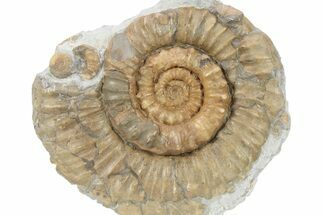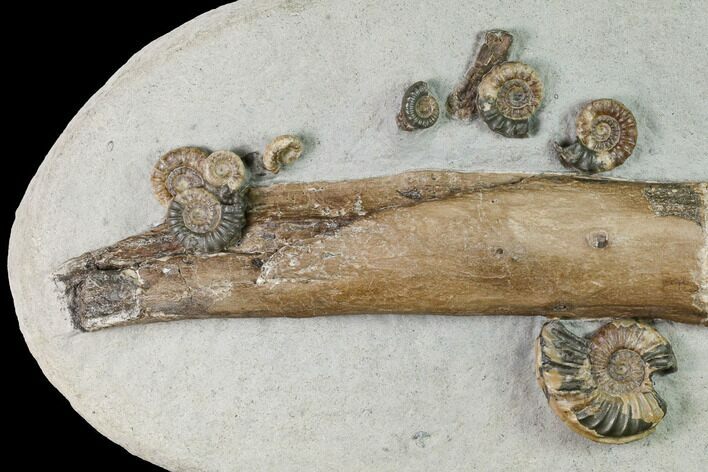This Specimen has been sold.
Jurassic Ammonite & Petrified Wood Association - Dorset, England
This is a gorgeous association of ammonite fossils and petrified wood within a concretion, collected from the Lyme Regis region of England. The largest ammonite (Asteroceras confusum) is 1.7" wide and has a bite mark from a predator. The smallest ammonites are of the species Promicroceras planicosta. The preparation of the petrified wood is excellent and is centered across the middle of the specimen. It comes with a metal/acrylic display stand.
About Ammonites
Ammonites were ancient marine cephalopods, similar to today's squids and octopuses, but with a defining feature: their distinctive, tightly coiled spiral shells. These shells, resembling those of modern nautiluses, served as both a protective home and a buoyancy aid, allowing ammonites to navigate the prehistoric seas with ease. First emerging around 240 million years ago in the Triassic Period, ammonites thrived for over 175 million years, adapting through numerous forms and sizes. As predatory creatures, they likely fed on smaller marine organisms, using their tentacles to capture prey. However, their long reign came to an end 65 million years ago at the close of the Cretaceous, coinciding with the mass extinction event that also eliminated the dinosaurs.
Ammonites were ancient marine cephalopods, similar to today's squids and octopuses, but with a defining feature: their distinctive, tightly coiled spiral shells. These shells, resembling those of modern nautiluses, served as both a protective home and a buoyancy aid, allowing ammonites to navigate the prehistoric seas with ease. First emerging around 240 million years ago in the Triassic Period, ammonites thrived for over 175 million years, adapting through numerous forms and sizes. As predatory creatures, they likely fed on smaller marine organisms, using their tentacles to capture prey. However, their long reign came to an end 65 million years ago at the close of the Cretaceous, coinciding with the mass extinction event that also eliminated the dinosaurs.
What Is Petrified Wood
Petrified wood is the name given to wood that has been turned into stone (fossilized) through the process of permineralization. In this process, all of the organic matter becomes replaced by minerals, while much of the original structure, such as tree rings, is retained. For this to happen, the wood needs to be buried in an environment low in oxygen to prevent decomposition and with flowing, mineral-laden water, so minerals may replace structures. The coloration is caused by various minerals/impurities present in the water during fossilization. For example, red colors in many cases can be attributed to iron compounds, greens due to copper, and so on.
Petrified wood is the name given to wood that has been turned into stone (fossilized) through the process of permineralization. In this process, all of the organic matter becomes replaced by minerals, while much of the original structure, such as tree rings, is retained. For this to happen, the wood needs to be buried in an environment low in oxygen to prevent decomposition and with flowing, mineral-laden water, so minerals may replace structures. The coloration is caused by various minerals/impurities present in the water during fossilization. For example, red colors in many cases can be attributed to iron compounds, greens due to copper, and so on.
SPECIES
Asteroceras confusum, Promicroceras planicosta & Unidentified Wood
LOCATION
Black Ven, Charmouth, Lyme Regis, Dorset, England
FORMATION
Lower Lias, Obtusum Zone
SIZE
Entire specimen 9.7 x 7.1"
CATEGORY
SUB CATEGORY
ITEM
#171275
We guarantee the authenticity of all of our specimens.
 Reviews
Reviews


















